Textile art lends itself perfectly to depicting birds. Delicate stitches and the frayed edges of appliqué fabric snippets are perfect for replicating those feathery details.
Many artists like to feature birds in their work, revealing their varied and quirky characters, or their graceful natures. In this article we’re sharing the work of five textile artists who use a range of techniques to illustrate birds.
We take a look at Sophie Standing’s colourful, machine embroidered appliqué art, Liz Jeary’s photobroderie, and Megan Zaniewski’s beautiful thread paintings. And we explore the sketched collages of Nigel Cheney and the graphic work of Stephanie Redfern, who both make use of innovative digital printing methods, combined with more traditional embroidery stitching.
Stephanie Redfern
Stephanie Redfern is inspired by the natural world, museum collections, and the fabrics that she produces using various methods. She is intrigued by birds, in particular; she likes to watch them go about their lives, flitting about the garden. She puts out food for them, and that small involvement in their world gives her a real sense of privilege.
Her latest ongoing project is Stories of the Bowerbird, a response to her methods of collecting and making, using a variety of media. Birds started to appear in her work regularly after she made an artist’s book called The Stone Bird. Stephanie often finds that even if she doesn’t plan to involve birds in her work, they invite themselves in. She’s also intrigued by nests, which she finds ideal subjects for mixed media and three dimensional work.
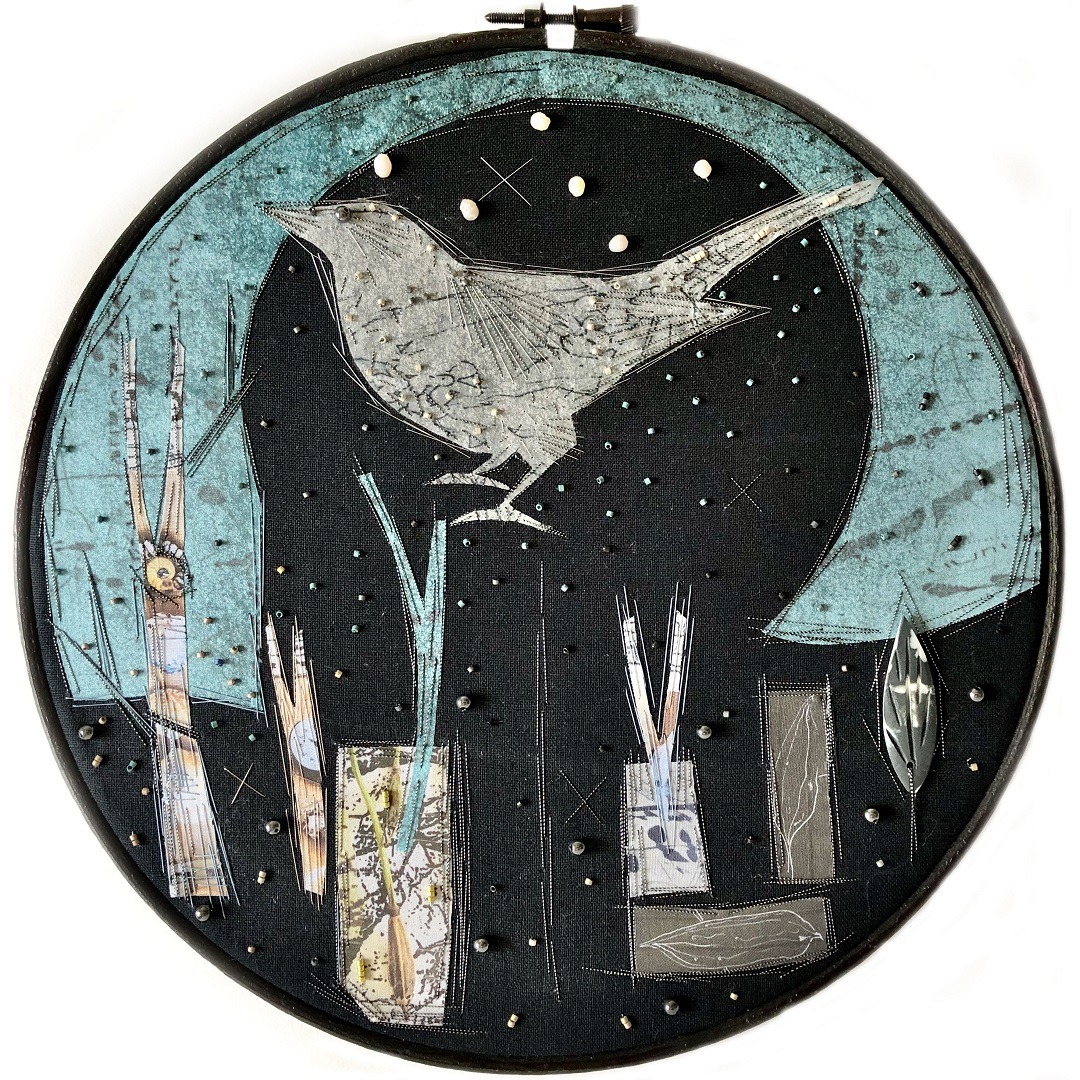
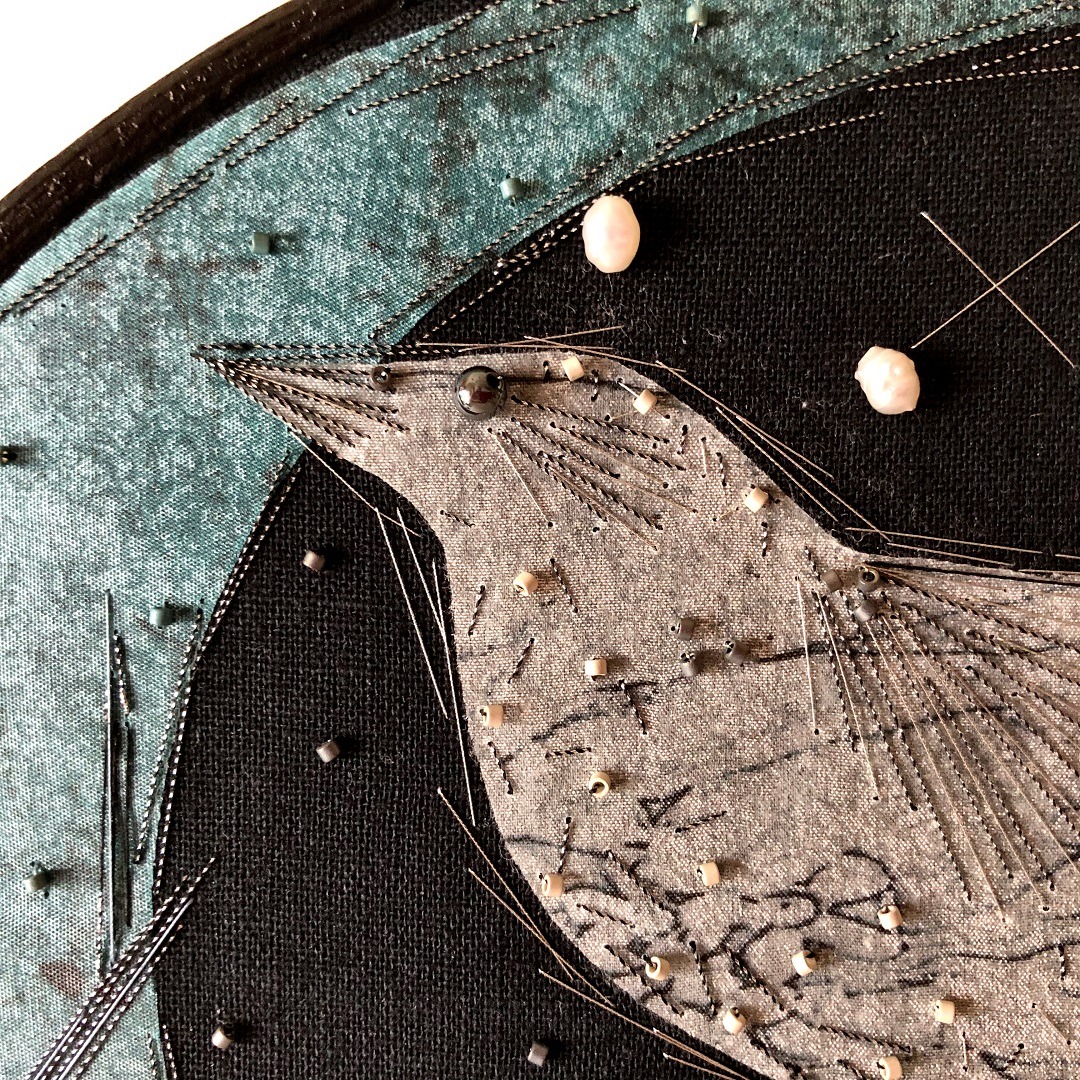
The enigmatic blackbird
Stephanie’s favourite bird is the blackbird, which features in a series of six pieces called Natural Histories. The series is based on a collection of simple drawings of blackbirds; Stephanie likes to work with their distinctive shapes, using a variety of fabrics.
The dramatic night scene is defined by its dark background, a black linen. The appliquéd silk fabric is digitally printed, and lightly hand stitched with cotton and metallic threads, so as not to obscure the detail in the fabric designs. The beads become part of the narrative, making marks in the sky. And there’s a black and white porcelain leaf stitched into the design.
The digitally printed white silk suits the enigmatic nature of the piece. Stephanie describes the work: ‘It’s a quite secretive series, with the added mystery of the night in this work. This world is, in part, revealed to us by the bird. It’s a familiar creature but also unknown to us, spanning that inscrutable world and our own.’
Stephanie’s work includes painted and printed fabrics, created using blocks and Thermofax screens with acrylic paints, inks and dyes. Lately, she’s been digitally printing cotton and silk at home, using her own photographs and images of her mixed media collages, which often include natural objects such as plants, shells and fossils.
The layering in her digital prints adds a fascinating depth to the fabric, which Stephanie hopes intrigues the viewer.
These fabrics become the appliqué shapes she uses to build up the work, which she attaches using heat-fusible webbing to produce a crisp, graphic finish.
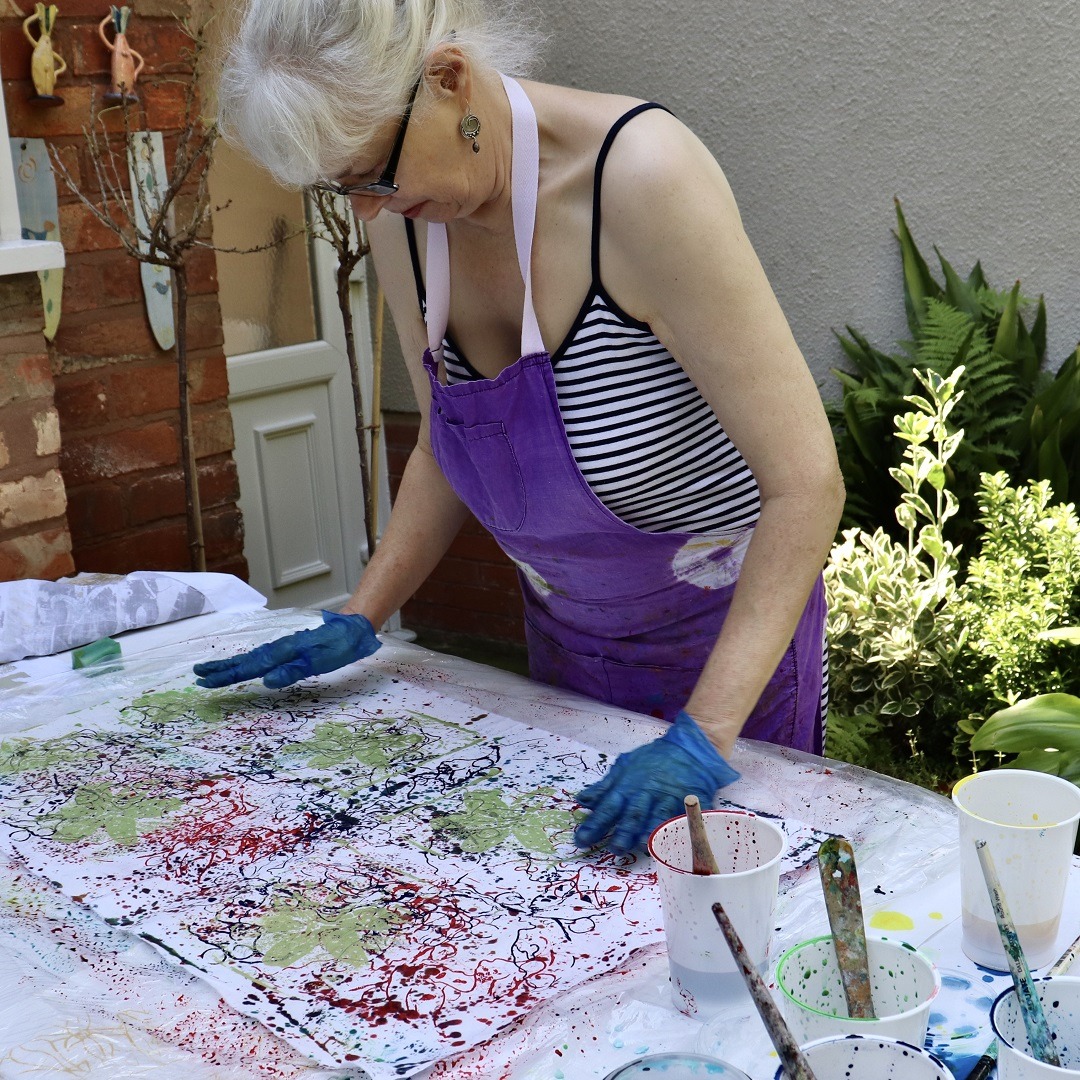
Stephanie Redfern is based in Birmingham, UK. A ceramist for 20 years after leaving art college, she began working in textiles and mixed media in 2003. Her work consists of artist’s books and stitched textile works, which often incorporate mixed media such as porcelain, glass, plastic, wood and stone. She’s the author of Stitched Textiles: Nature (2018).
Website: stephanieredfern.co.uk
Facebook: Steph Redfern
Instagram: @stephredfernart
Megan Zaniewski
Megan Zaniewski loves the challenge of depicting the motion of birds as they traverse land, sky, and water. Her quirky split-view hand embroidered water birds depict a graceful and calm facade above the surface, juxtaposed with a whimsical liveliness below.
Describing herself as fairly quiet and reserved by nature, for American Pekin, Megan decided to set aside these tendencies and embrace something different.
‘I wanted the entire piece to convey a more playful and lively scene, showing the commotion created by the duck, and I think the piece reflected a lot of the changes taking place in my own life at the time.’
She begins by researching the bird species and sketching ideas, going on to draft three or more patterns before settling on a final design. Her thread paintings are stitched entirely using stranded embroidery cotton threads, and she selects the colours while she works, focusing on one section at a time.
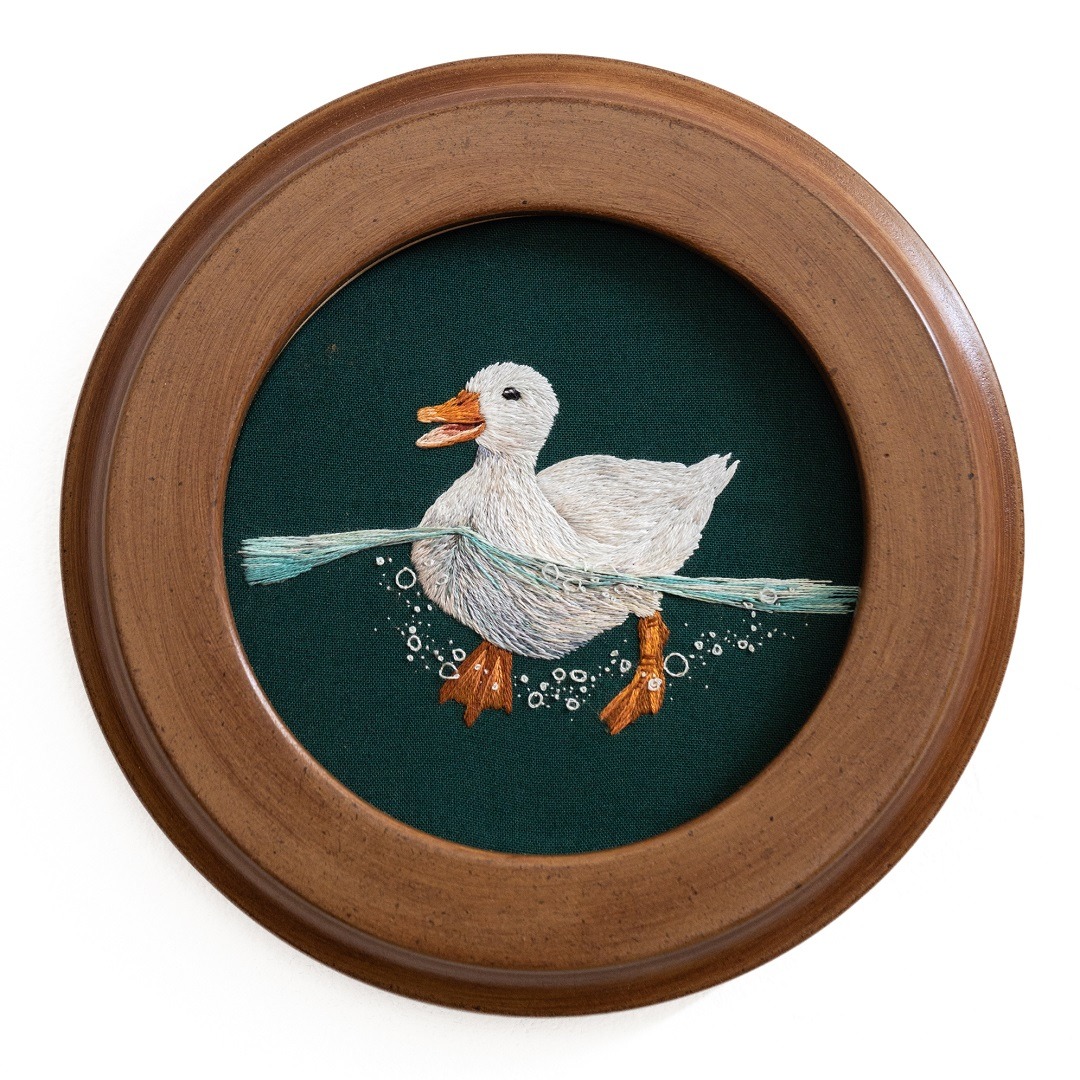
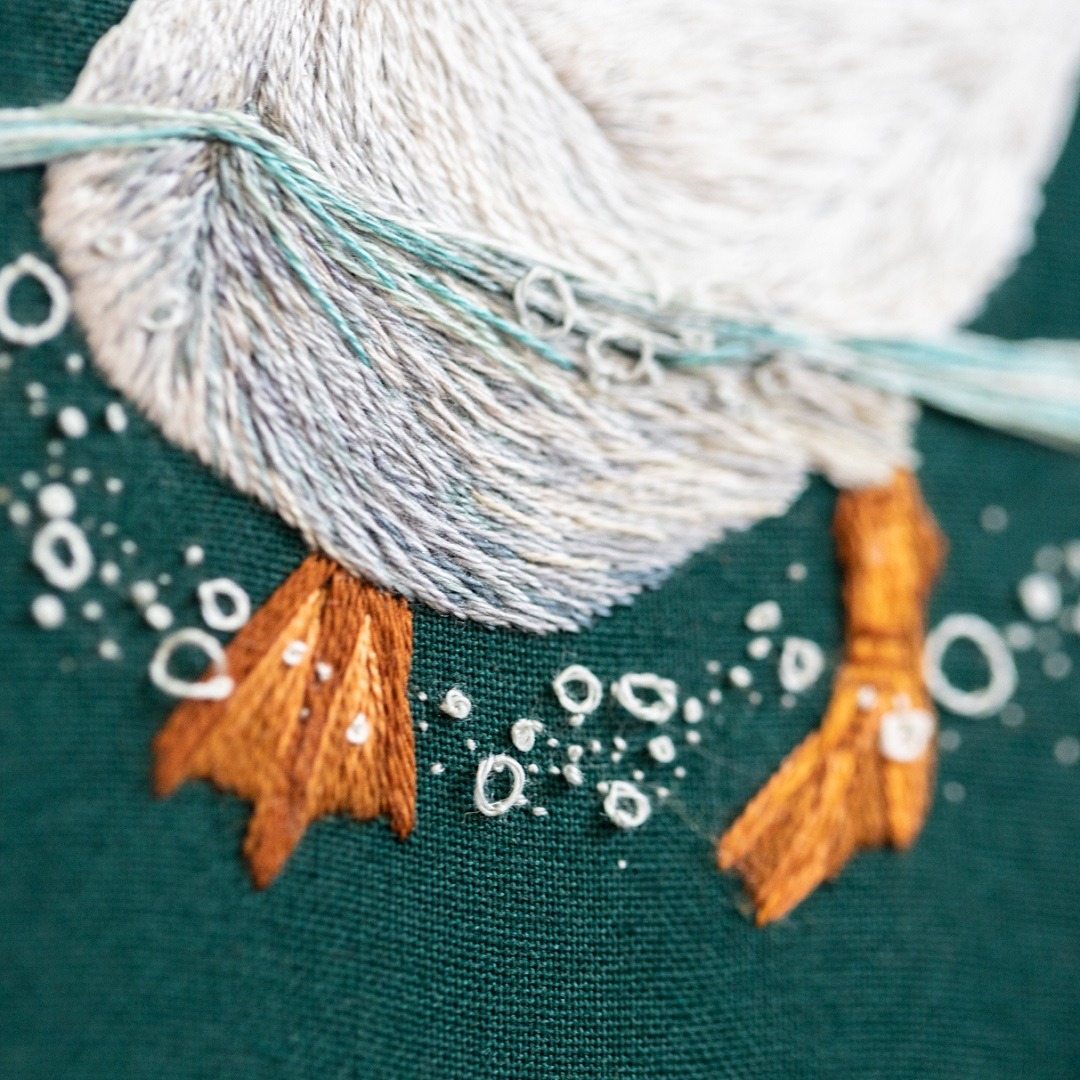
Facial features first
Megan knew the most important step when creating American Pekin would be capturing its lively and cheerful expression, so she embroidered the facial features first, beginning with the eyes, beak and facial feathers, before moving onto the rest of the body.
Above the water, she wanted the feathers to appear drier and more ruffled, so she altered the directions of the stitches and worked in brighter whites. Below the water, Megan wanted to mimic the smoothness of the feathers in the water and the shadows cast by the water on the duck. She achieved this by placing the stitches in the same direction as each other, incorporating blue and grey threads. She finished by adding the waterline and bubbles, using long and short stitches, french knots, and peking knots.
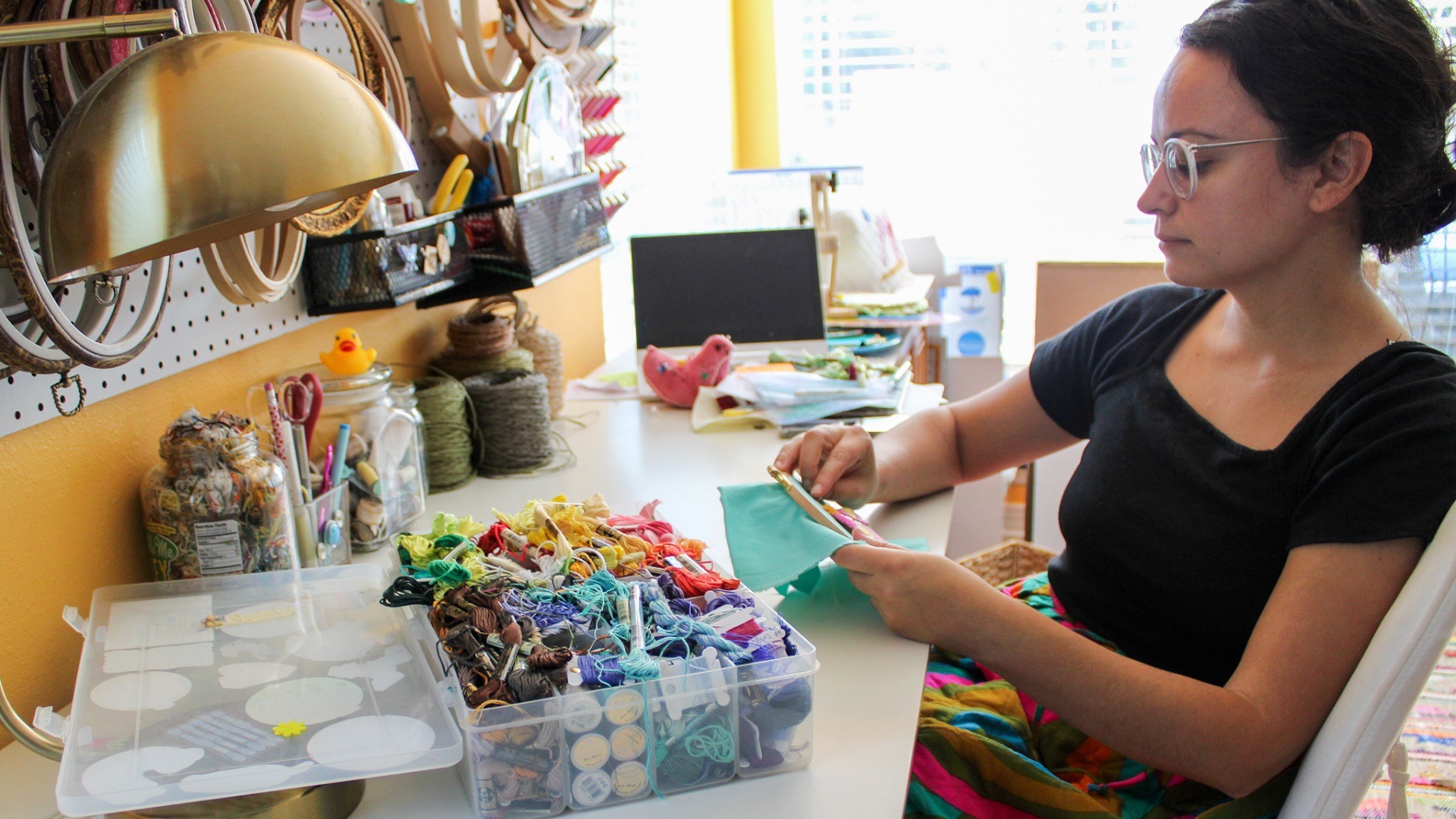
Self-taught hand embroidery artist Megan Zaniewski is based in Biloxi, Mississippi, US. She is known for her thread painting and three-dimensional stumpwork creations, capturing nature in realistic detail. Her work has been featured in the Colossal and Modern Met blogs, and was exhibited in the Paradigm Gallery + Studio, Philadelphia in their Division of Birds exhibition, 2022.
Instagram: @megembroiders
Nigel Cheney
Nigel Cheney has drawn, painted and stitched birds since he was a child. This interest was inspired by his mum and her habit of talking to the birds at the back door. Nigel has always had a soft spot for robins, who visit without fear and demand food.
Nigel describes himself as a lacklustre wildlife photographer, too busy stitching to take the high quality photographs he aspires to. But his social media scrolling often leads him to feeds like that of Rachel Treweek, who documents the robins that visit her on the canal. He explains: ‘Rachel brings such passion and knowledge to her depictions of their routines. I feel richer for knowing Arfur, Dutch and Rodney through her virtual introductions, and I’m in great debt to her generosity in sharing that inspiration.’
Preferring to work in a series, he gathers a wealth of imagery, materials, drawings and fabrics and focuses on the fun of making.
With a tendency to over-work and over-analyse, Nigel finds that by spreading his energy over several works he can keep things fresh.
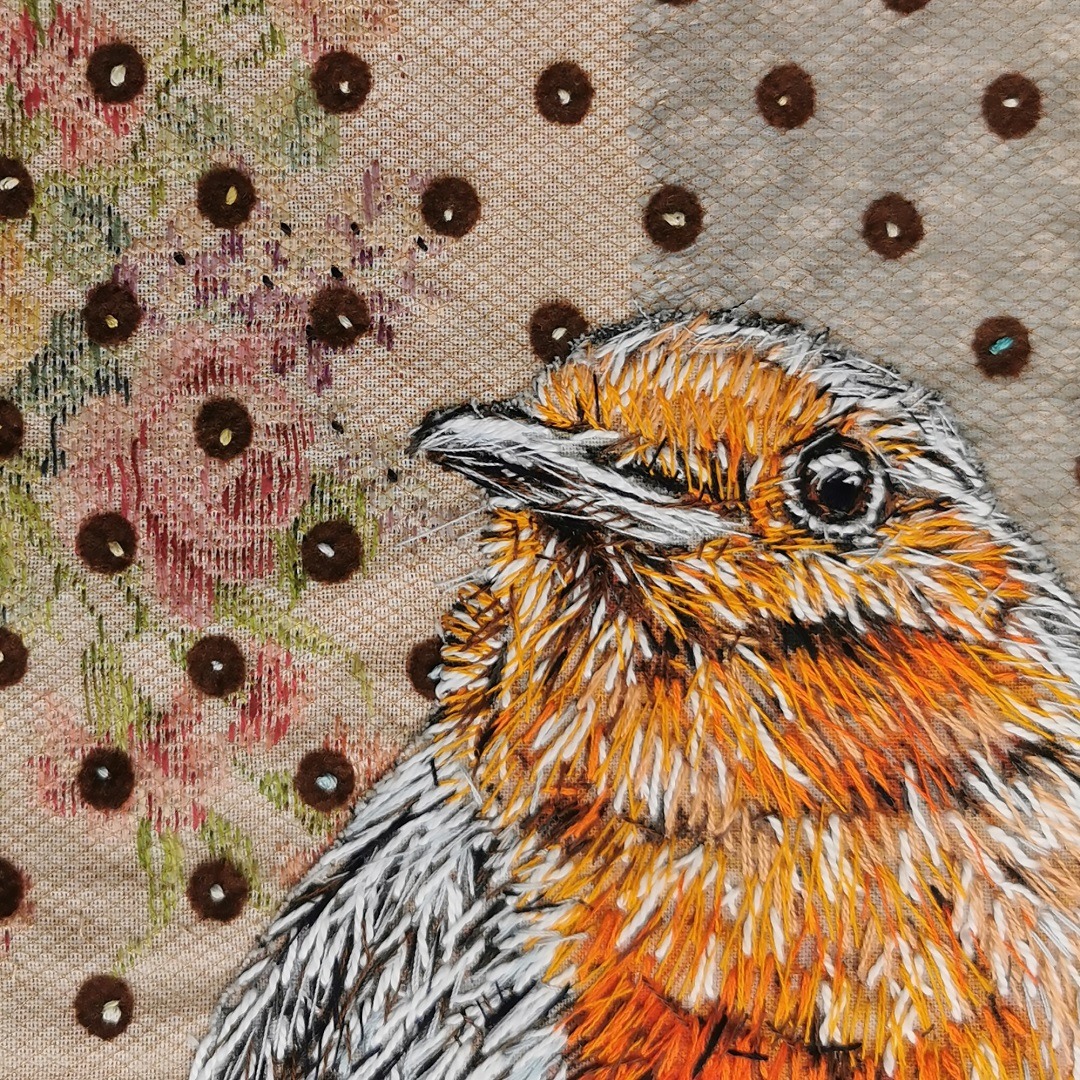
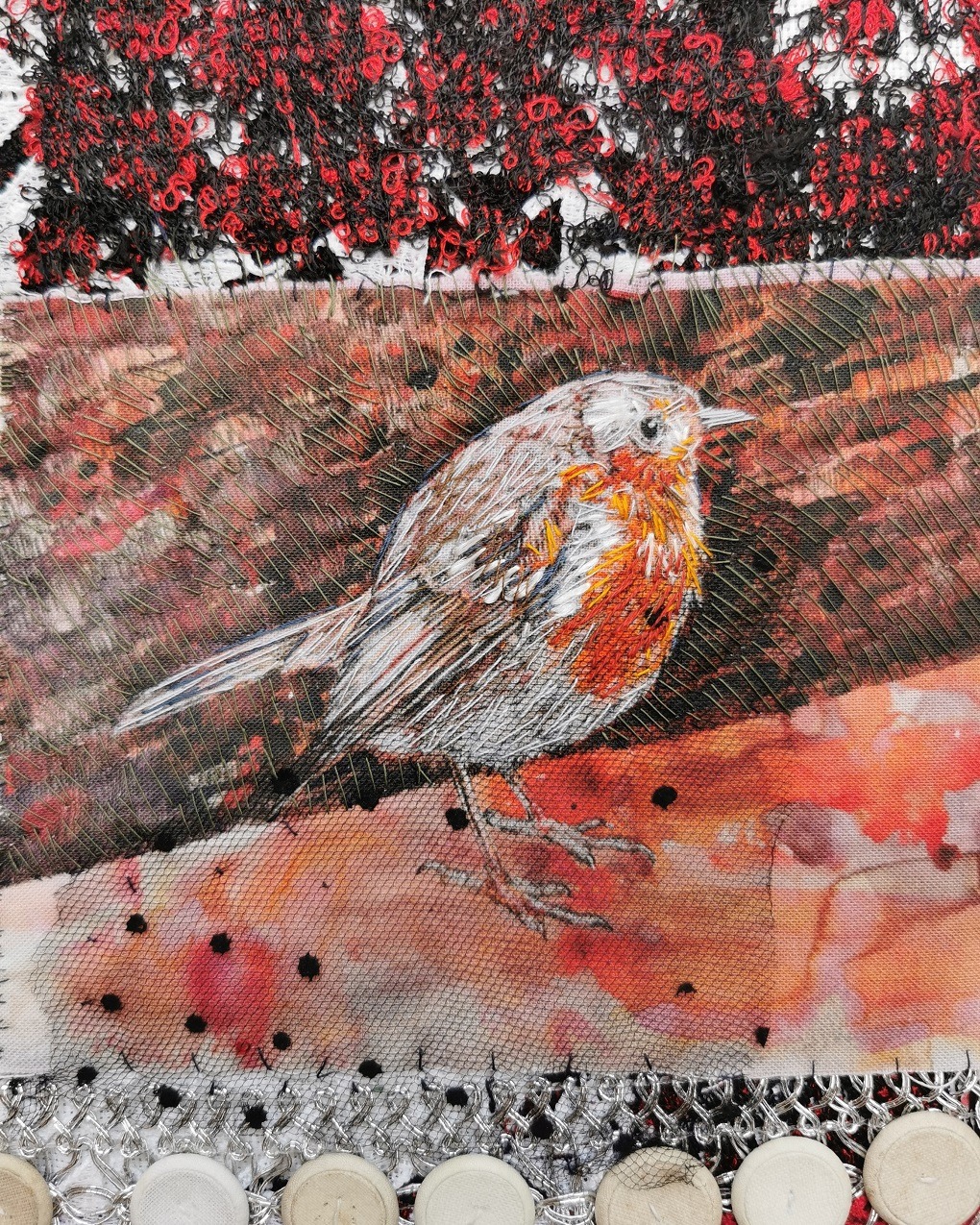
Drawing is central to his work
Nigel drew his robins using a pen, nib and brush in Indian Ink, acrylic ink and fine-liner, with a sprinkling of salt onto some of the washes. These were scanned and digitally manipulated before being sent to PRINFAB, a fabric printing company.
Then Nigel built a ground using a selection of fabrics, continuing to pin, reflect and re-pin until a balance was achieved. Then he slip-stitched the fabric fragments in place.
For the birds, he stitched the details using an open and more gestural type of silk-shading; simple drawing stitches to reflect the movement and surfaces he’s aiming for.
Cross-hatching is another favourite method, using threads in three different tones to blend colour. Nigel chooses a variety of weights of thread, making selections based on colour and sheen, moving from thick crochet cotton, to stranded embroidery cotton, to fine machine thread, creating texture and movement, as if the robin has just landed nearby.
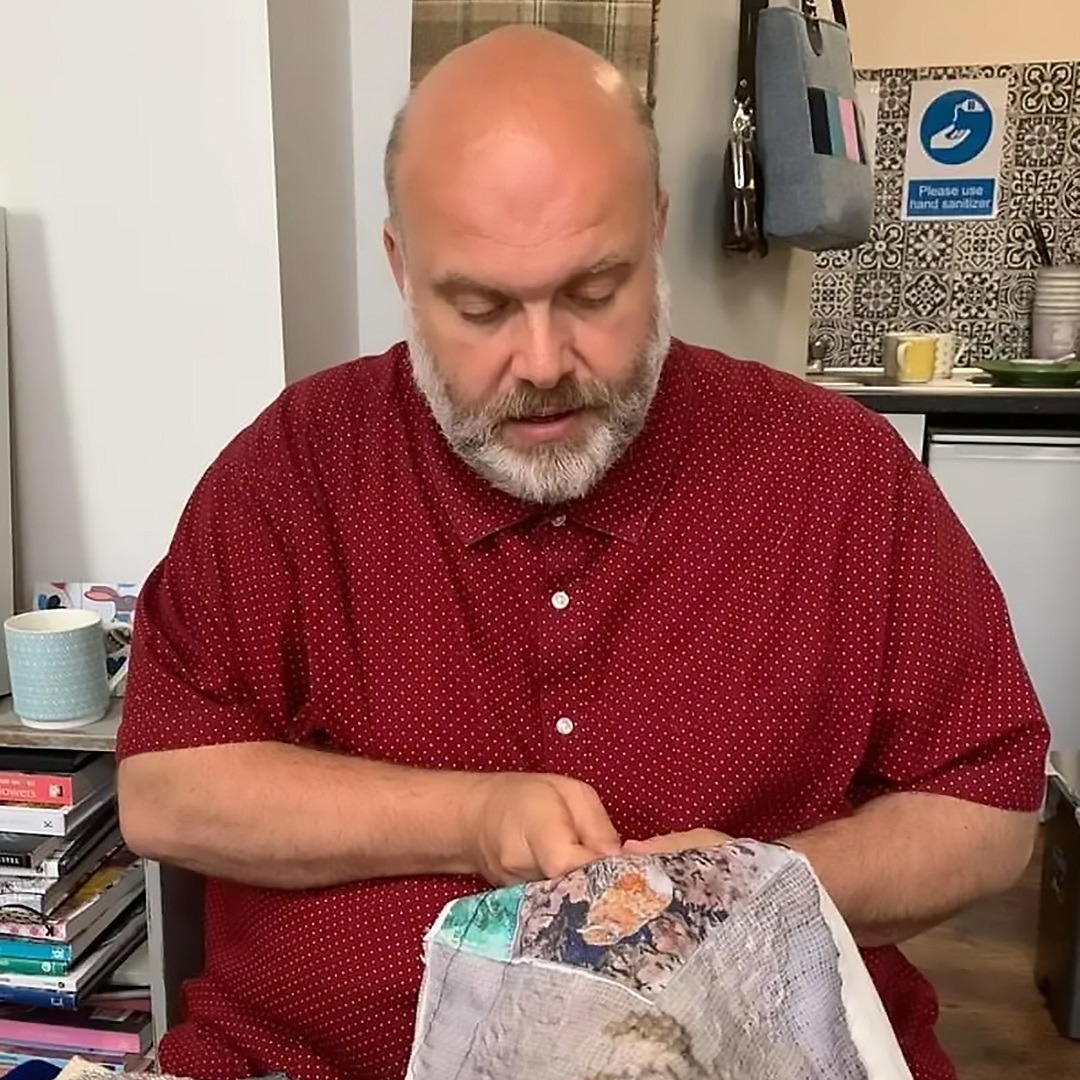
Nigel Cheney is an embroiderer based in Market Harborough, Leicestershire, UK. He was a finalist in the Vlieseline Fine Art Textile award 2020 and a finalist in the Hand and Lock Embroidery Prize, Open Textile Art category, 2022. He held the position of Lecturer in Embroidered Textiles at National College of Art and Design, in Ireland, for over 20 years before retiring to live in his native Harborough.
Website: nigelcheney.com
Facebook: facebook.com/nigel.cheney/
Instagram: @nigelcheney
Sophie Standing
When creating the face for her work Ostrich, with its classic, comical expression, Sophie Standing used a jaunty angle to show off the beak.
‘With any portrait it is important to get the right angle. A slightly skewed angle is often better than looking straight on or a side profile.’
Sophie is a wildlife artist who uses free machine embroidery and appliqué to create her works. She told us she had lots of fun creating her Ostrich work, especially when stitching those characterful eyes and long eyelashes.
She draws her portraits on cotton canvas which has been eco-dyed or painted with acrylics, adding fabric shapes using fused appliqué, to create the face and body.
Sophie says: ‘I have a very large collection of fabric. Mostly I use Kaffe Fassett Collective fabrics and Liberty tana lawn cottons. But I also have a large collection from other designers and companies, including Anna Marie Horner, Moda, and Cotton and Steel.’
‘For me, the fabric appliqué is like my first blobs of paint. I select fabrics before I start, but I also let myself play around with them, particularly as I move away from the face of the animal.’
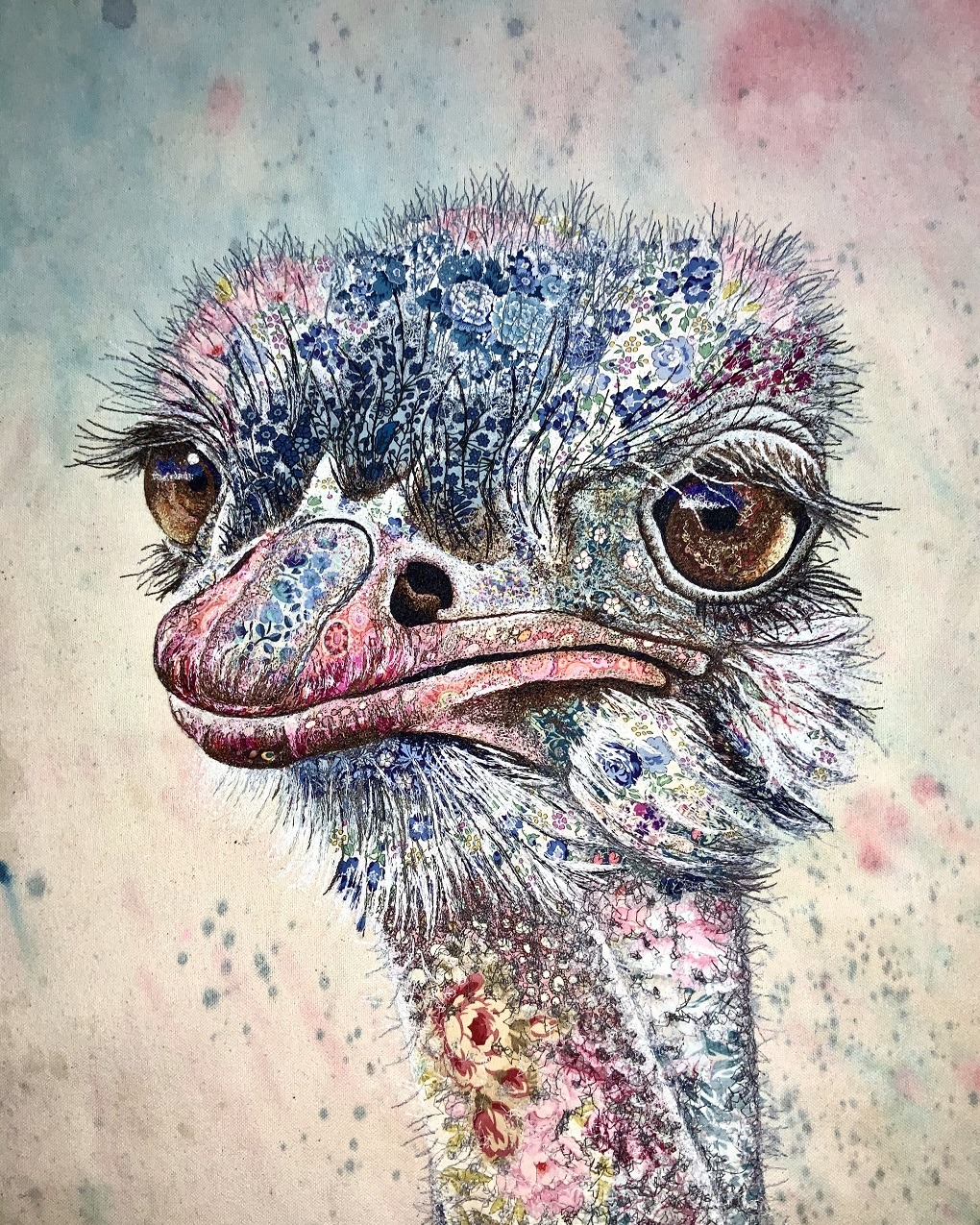
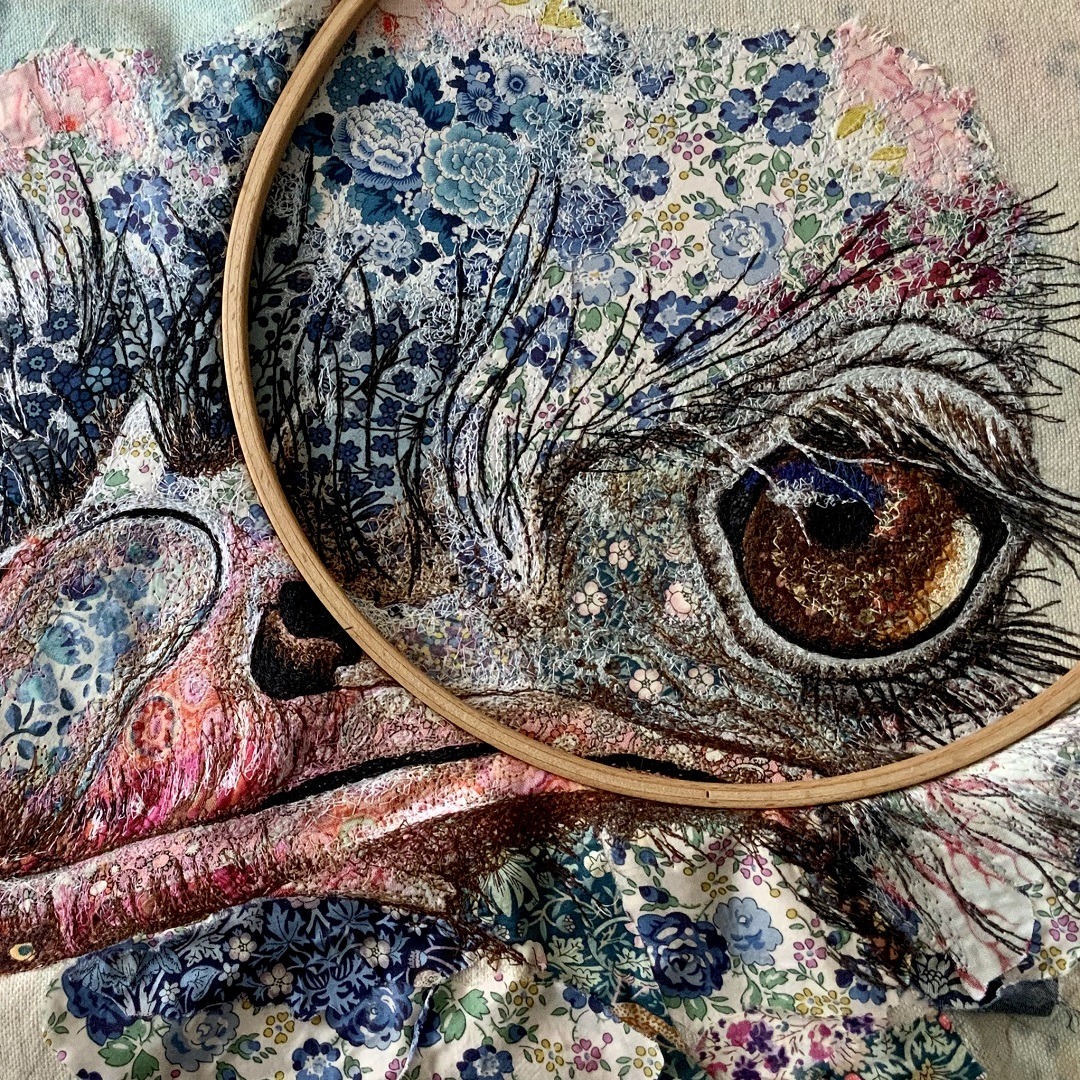
Fabric in the soul
Living in Africa for 22 years has influenced Sophie’s artwork, but her love of fabrics is ingrained into her soul.
‘Fabric, thread and all things sewing have always been a big part of my life. Aged 13, I worked in a fabric craft shop, and I worked in Liberty of London in my twenties. My memories of growing up in the English countryside in Hampshire are full of chintzy fabrics and floral smock dresses.’
Colour is a big factor for Sophie. Whether it’s her clothes, interior decor or her artwork, she has never been shy of colour bursts. Occasionally she’ll stick to a more subtle palette, such as for her stitched apes and some of the birds she stitches, especially the ones that are so delicate she feels it’s inappropriate to use vibrant floral fabrics.
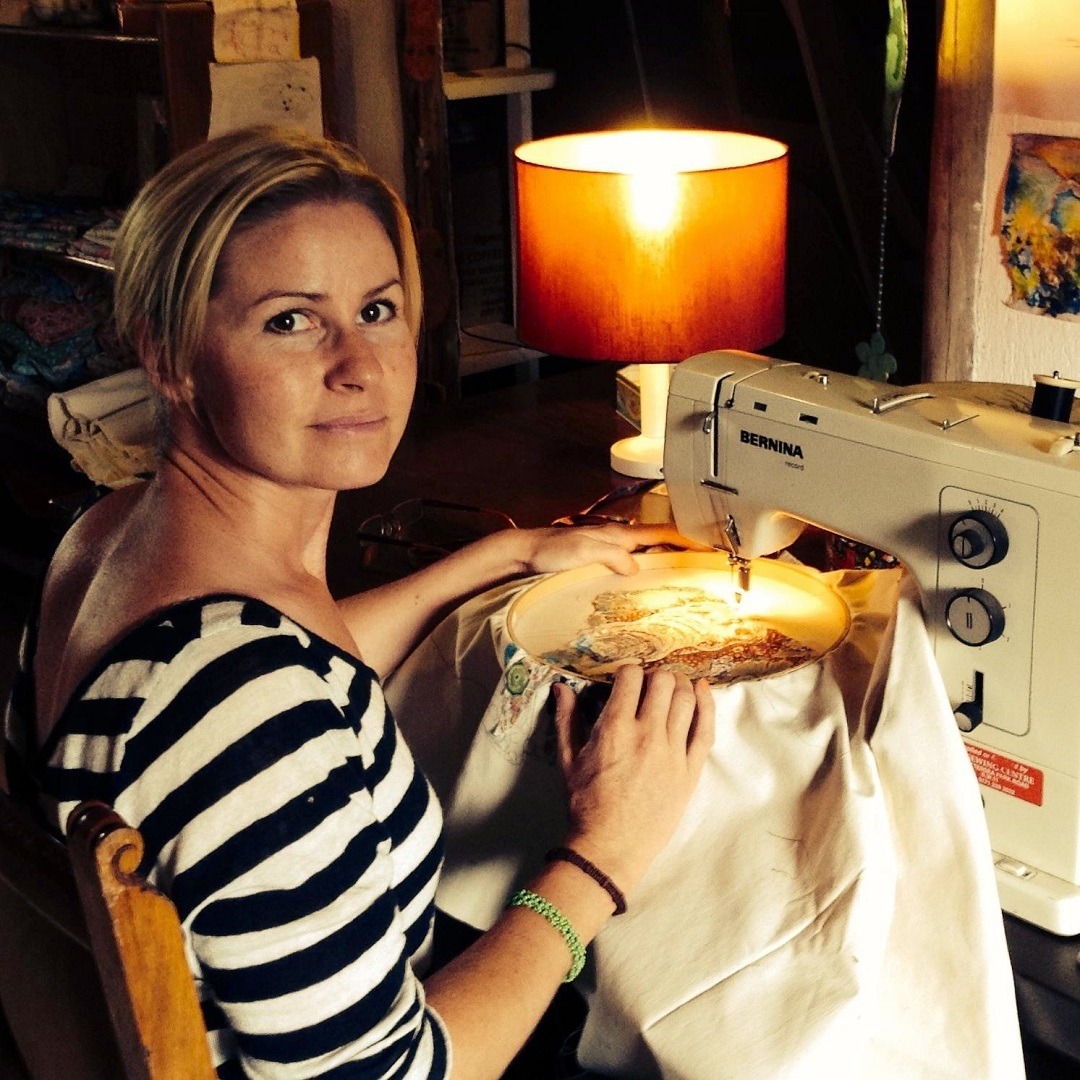
Sophie Standing is a textile embroidery artist. She grew up in Hampshire, UK, spent 22 years living in South Africa, Seychelles and Kenya, returning to Frome, Somerset, UK in 2022. Her work featured in Kaffe Fassett: The Power of Pattern exhibition, London Fashion and Textile Museum, 2022-2023.
Website: sophiestandingarts.com
Facebook: Sophie Standings Textile Art
Instagram: @sophiestandingart
Liz Jeary
Another bird watcher is Liz Jeary, who loves colourful birds like parrots and peacocks. She’s drawn to their behaviours and personalities. Watching and photographing birds brings her joy, so she often visits zoos, wildlife parks, and sanctuaries, to photograph many different birds.
Most people are mesmerised by peacocks and their amazing spread of feathers, although Liz finds that it’s easy to become desensitised to their true majesty when viewing photographs, as the movement and sound of their display is not apparent. She wanted to remind herself of how beautiful and majestic these birds are, so she chose to embellish an image, which was taken at Dublin Zoo in 2017.
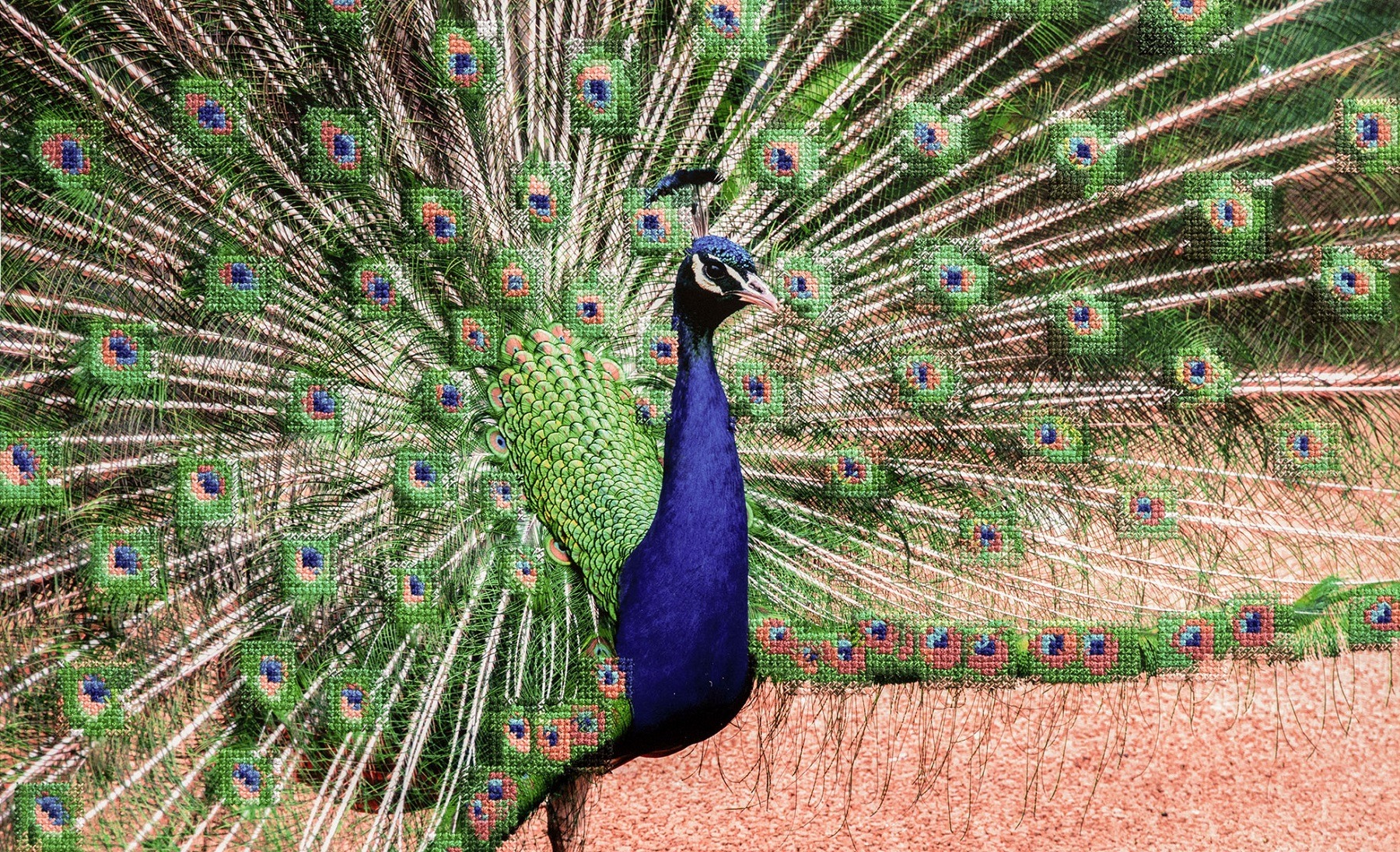
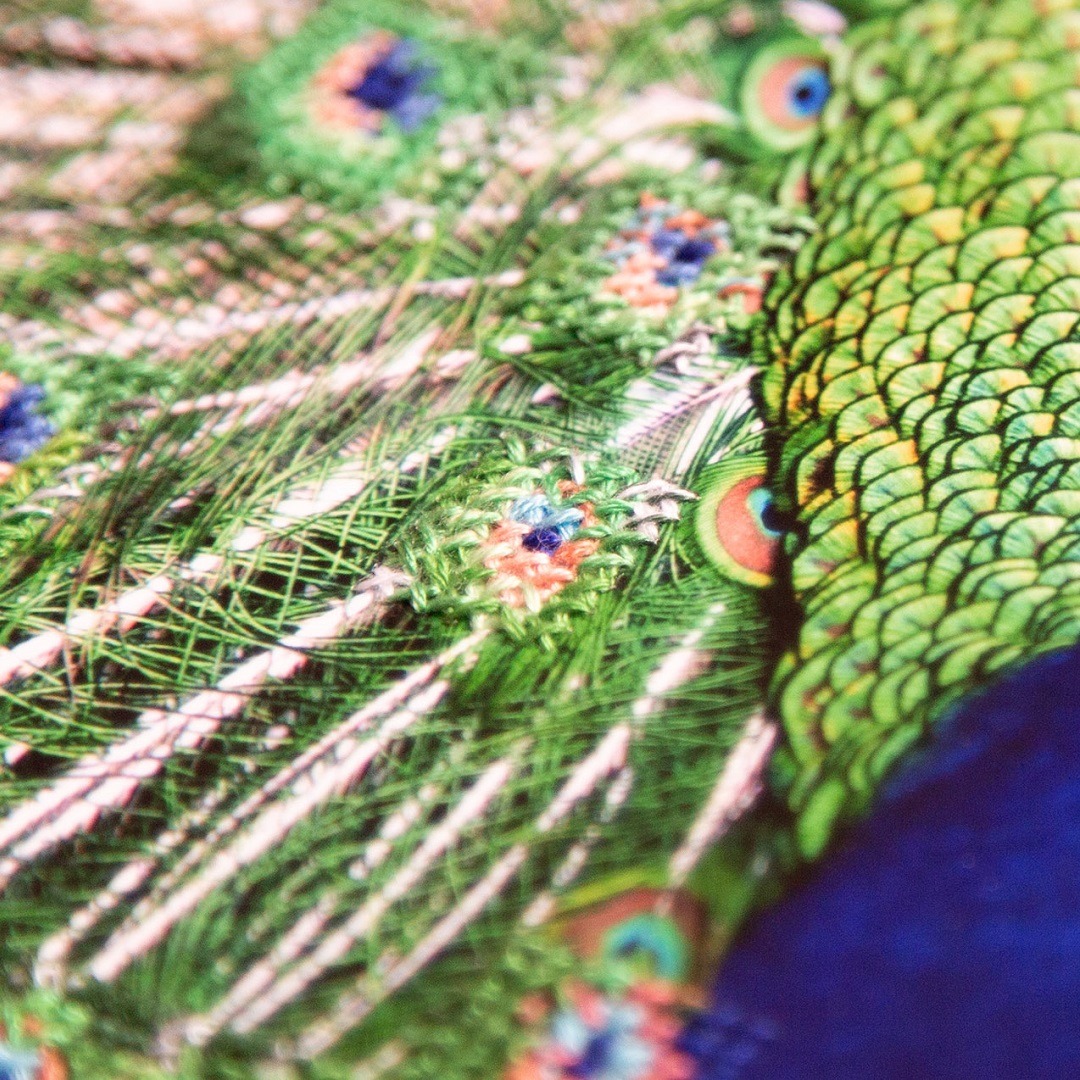
Seventy five ocelli
Liz chose cross stitch to give a pixelation effect, to see if the ocelli (the spots on the tail feathers) would have the same appeal if they were slightly obscured. It was a huge challenge to work small stitches on a large print; she needed to keep the stitches small, in order to retain the colours and details of the feathers.
Having started stitching, she became overwhelmed by how much work would be involved, and gave up after just a few hours of effort.
But it’s always worth going back to that ‘to do’ pile…
Over a year later, although she was working throughout the pandemic lockdowns, she found she had more time outside work. This gave her the drive to pick it up again, and get it finished. Liz reached 50 hours of stitching, but then stopped counting. Completing the piece had become the important part, no matter how long it took.
The work is called Seventy Five, as this is how many ocelli are visible. Liz estimates there’s around 15,000 single stitches in the finished work. And although there are some creases, she was pleased she avoided tearing the print during the project.
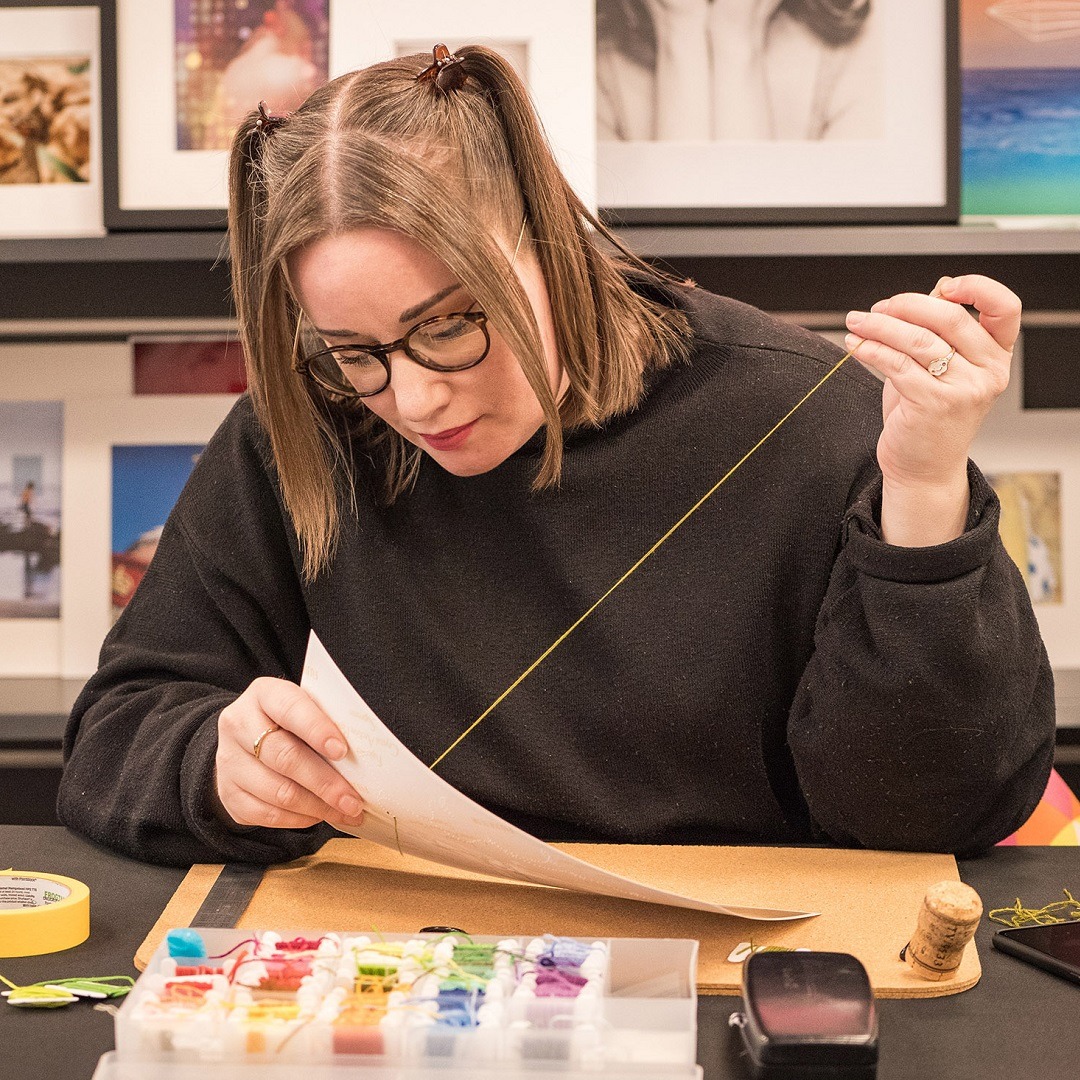
Liz Jeary is a fine art photographer based in Wirral, Merseyside, UK. She specialises in Photobroderie – the hand embroidery of photographic prints. Her work has been exhibited and published internationally, and she has artworks in several private collections.
Website: lizjeary.co.uk
Facebook: lizjearyphotography
Instagram: @lizjearyphoto
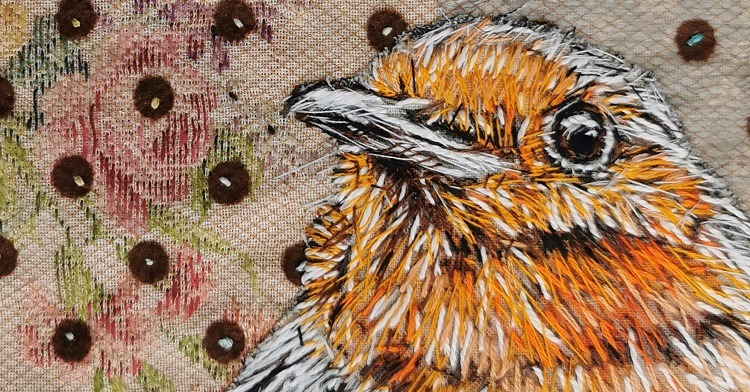
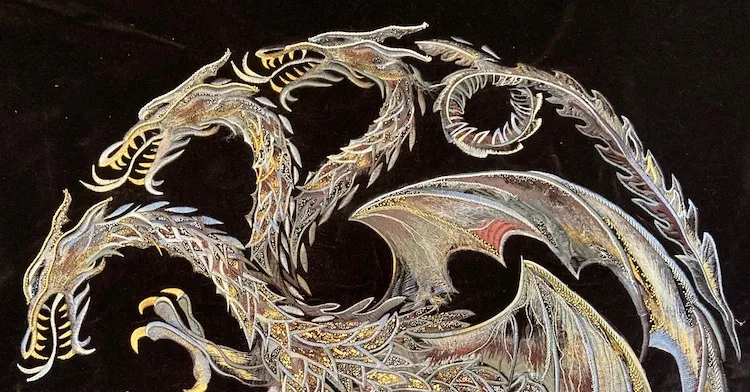
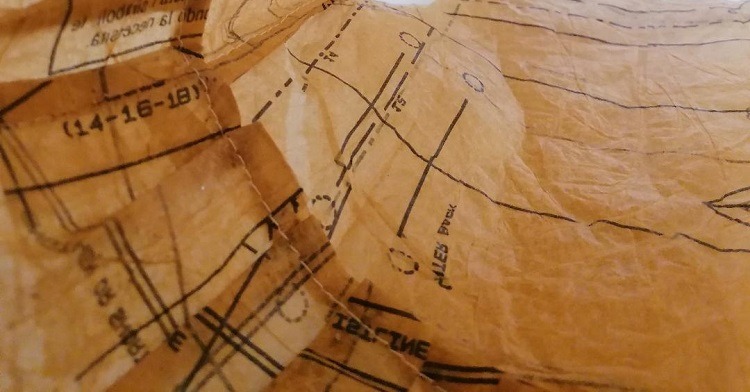
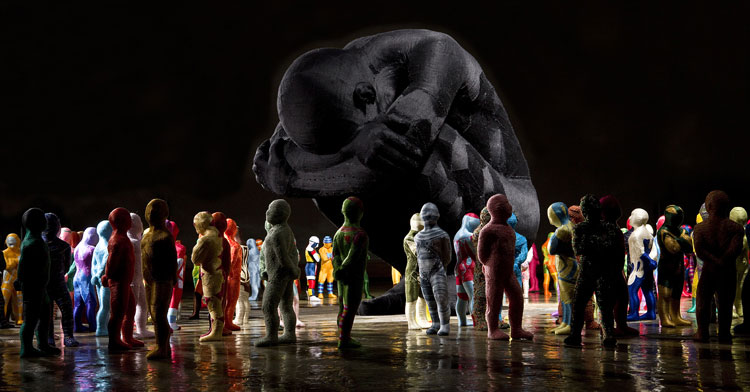
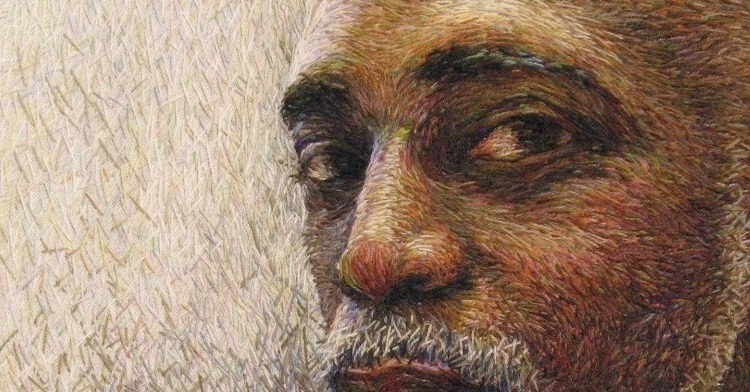
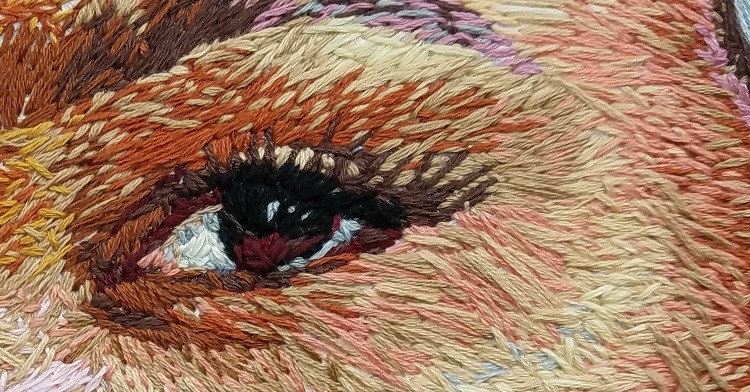
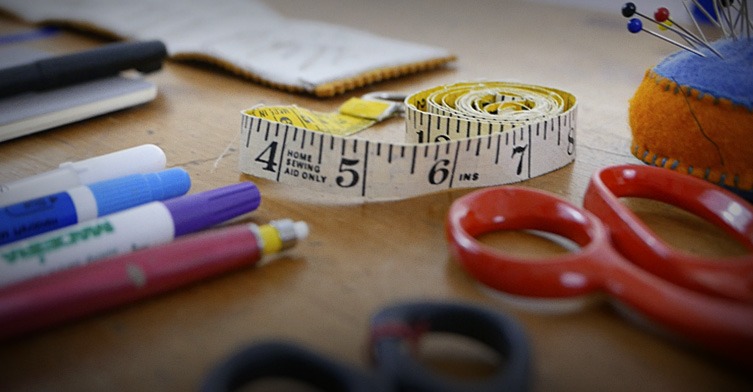
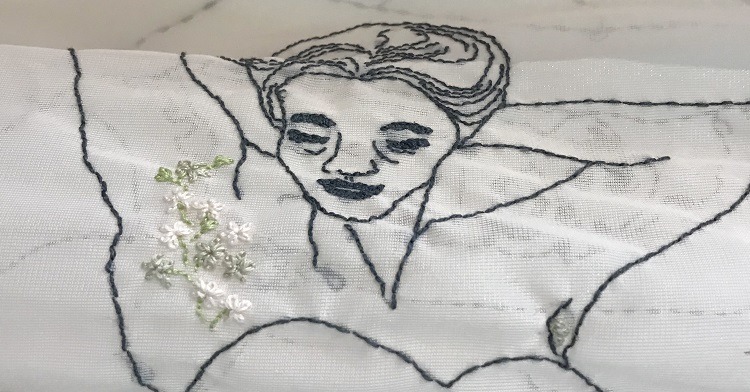
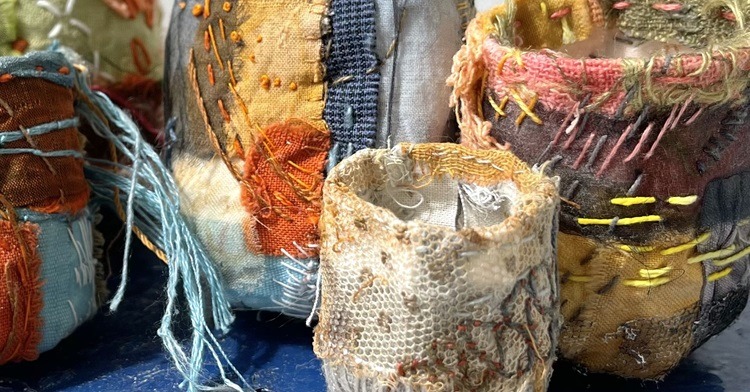
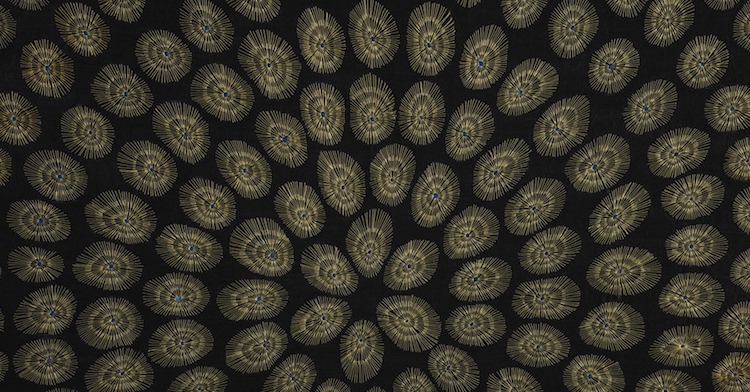
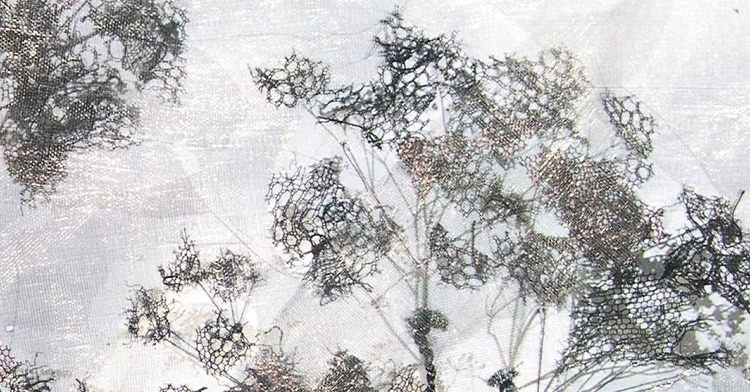
10 comments
Kathryn Kerr
Kathryn Harmer Fox makes stunning bird appliques/stitcheries. https://www.facebook.com/kathryn.art/
Lisa
NocolaJarvis ( uk) is also great with the birds
Jill
Another talented Australian artist, Jan Clark, also often features birds in her artwork, both textile, drawing and painting. Check out “Go Create”.
Cheryl Bridgart
Textile artist embroidering dream inspired birds (often with portraits) in freestyle in only thread – instagram @bridgartcheryl or http://www.bridgart.com in Adelaide Australia.
Pat Klein
As I looked at each image of birds I found myself saying, “Oh my heavens!” As I am sitting here in suburban Philadelphia having my breakfast checking e-mails and looking at Nature Conservancy magazine ! Thank You!
Ruth Petersen
i love what you have shown. For something a bit more quirky take a look at Ruth Packham. a Welsh artist using needlefelting. http://ruthpackham.com/?page_id=1023
Rosie Langton
And Mandy Patullo?
k3n
My friend Angela Knapp creates fabulous pieces featuring birds using fused appliqué and free machine embroidery. Her work will be on show at the West Country Quilt and Textile Show at Bristol University in November.. You can find her on Facebook as the Cary Made
Linda Grashoff
My friend Renee Harris often uses bird imagery in her embroideries. See http://www.reneeharris.net/Pages/GalleryBirds.html.
Shaila
It’s a great joy receiving these mails. A lot to learn from various artists!